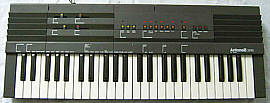 |
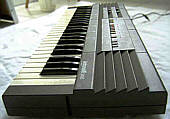 |
|
This Antonelli keyboard from 1988 (sound IC date?) was technically more modern than the analogue Antonelli 2381, but still behind its time since it had only 10 preset sounds and analogue percussion although it has already MIDI and a changeable key split point. Great is the versatile accompaniment with arpeggio.
 |
 |
A shorter 41 keys version of this instrument was released as Antonelli 2416 (retail price 698DM despite same hardware). The 2495 was apparently also released as Suzuki PK-49 (told by e-mail) and with different case style as Siel MK 490 (seen on eBay) and Giannini GK 4920 (seen in prospect), and a crippled version of that (37 keys, no midi, no sequencer) as Giannini GK 3710.
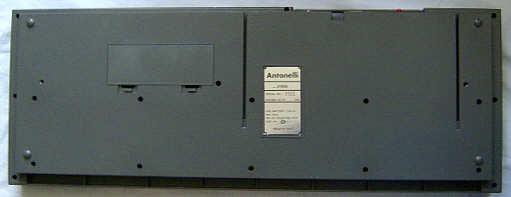 |
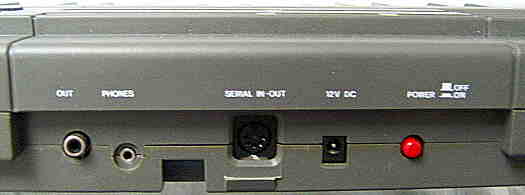 |
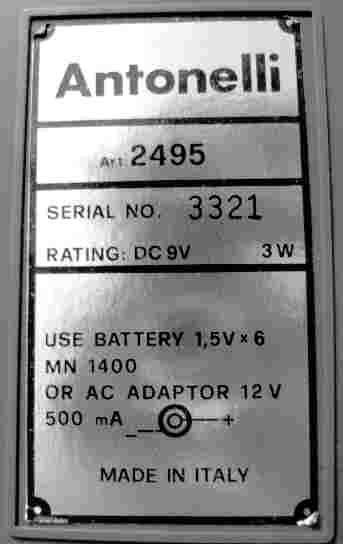 The
4 digit serial number 3321 hints that only quite small quantities of this
instrument were built. The
4 digit serial number 3321 hints that only quite small quantities of this
instrument were built. |
The main voice presets are digital waveform samples with capacitor envelope. Although they are labelled "digital pcm presets", the timbres are still quite warm, which may be also caused by a small dose of analogue distortion (especially during chords). The volume envelope control seems to be digital, because decaying notes partly turn buzzier and stop a little sudden. The "jazz organ" is a Hammond timbre (might be a filtered multipulse squarewave) without key click. The "pipe organ" is brighter and has a slower attack phase. The "piano" sounds like a well filtered squarewave timbre and gets somewhat brassy in the bass range. The "guitar" sounds like a differently filtered variant of it, which timbre is more like a harp. The "e.piano" shall be likely a Rhodes imitation and contains some glassy aliasing(?) overtones; in the bass range it gets a little buzzy, similar like squarewave based Consonant Vowel timbres of early Casio keyboards (see CT-410V). The "strings" has a quite realistic violin timbre with slow fading attack phase and vibrato. The "flute" might be a differently filtered version of "strings"; it has the same envelope and vibrato, but a dull flute timbre which slightly resembles a theremin and resembles a tuba in the bass range. The "accord." is a quite natural accordion timbre that seem to use the same filter like "strings". The "trump." is made from sawtooth wave and sounds more like a dull and slightly creaky oboe or cello than a trumpet; it contains vibrato and resembles somewhat a C64 timbre. The vibrato modulates the sound ICs internal clock oscillator, so it always also affects the accompaniment section. With the "sustain" button the release phase of the preset sounds can be prolonged. The keyboard can be transposed within 1 octave by pressing "transp." together with a piano key.
The analogue percussion sounds like typical home organ drums. There is a fill-in button (labelled "intro break") and instead of the rhythm also a "metronome" can be played, which consists of a knocking base with a tom drum on the 1st step. Unfortunately unlike with Antonelli 2381 the metronome here can not be combined with the automatic accompaniments of the rhythms (instead it switches into manual chord mode) and it also doesn't react on rhythm "start stop" and fill-in buttons. Interesting is that when "key start" and not "start stop" is pressed, the rhythm plays only so long any key in the accompaniment section is held down. It stops by releasing these keys and always restarts the pattern by pressing an accompaniment key. This way some weird breakbeat stuff can be played by trilling on the keys. With the tempo knob the rhythm tempo can be set very low but not extremely high.
The accompaniment here has a lot of features, those controls have partly odd names. E.g. when "bass" is pressed, the lowest note played in the left section of the keyboard is layered with a monophonic bass and this works not only with accompaniment or chord mode, but also with the normal melody voice. The bass is a soft and warm organ bass with sustain that sounds quite analogue. When "split & chords" is pressed, the left keyboard section plays a different sound that depends on the selected rhythm (also with rhythm off). These sounds correspond to the 10 main voice preset sounds except that they contain no vibrato (likely because vibrato is implemented by modulating the clock oscillator); even the sound number corresponds to the rhythm number (i.e. to select the 3rd sound "guitar", select the 3rd rhythm "country"). The key split also serves the purpose of a "fingered chord" mode; the only main difference is that you can use the full polyphony here. When "memory" is pressed, the current chord or key combination in the left section is held after releasing the keys until any new key is pressed. To change the key split point, press simultaneously "kbd select" and "transp." together with the intended key. (But the split point seems to be still only placeable within the 2nd keyboard octave). To enable the single finger chord, as well "O.F.C." as "split & chords" have to be pressed (both LEDs lit). To enable the automatic accompaniment, the button "modul." has to be pressed and a rhythm started. When "modul." is not pressed, the rhythm is simply combined with the normal manual chord (key split or single finger chord), thus this instrument does not urge you to use the automatic accompaniment but you can still play normal organ chord in the left keyboard section together with a rhythm. (Although this technically simple feature should be a matter of course and was available in most early home organs, it exists only in very few modern home keyboards.) You can even combine the arpeggio with manual chord play. The arpeggio plays a sort of banjo timbre while the chord timbre of the accompaniments depend on the rhythm they belong to. (The bass timbre of accompaniments stays always the same.) But in comparison to the cute and cheesy sounding Antonelli 2381, the 2495 sounds braver and more establishment- like, not least because the arpeggios of the 2495 are more generic. Each accompaniment is formed by a characteristic monophonic bass line and a rather generic arpeggio (both can be switched off), but it does not recognize chords in any way nor does it strum or otherwise melodically re-arrange the held notes from the accompaniment section into a complex pattern, but simply chops these notes rhythmically by the selected rhythm. This makes the accompaniments quite boring (the Antonelli 2381 had more complex arpeggios and 2 variations per rhythm), but great is that you can play here instead of chords any weird disharmonic note clusters those get also gated by the accompaniment into a wildly grunting sound.
The chord sequencer is a little awkward to use; it is very coarse, can not record pauses and does not work in realtime. In the catalogue stands that it can store 12 OFC (i.e. single finger) chords for the accompaniment. The "sequencer" button cycles between "rec." and "play" (LEDs lit). To record chords, press it once ("rec." is lit). Play the single finger chords one by one, and while holding each chord, press and release the "sequencer write" key to store it. Each press of "sequencer write" adds one bar of chord (i.e. press it multiple times to store longer chords). Press "sequencer" again ("play" is lit now) to finish. To play it, press "sequencer" until "play" is lit and then start a rhythm. The chord sequence will now repeat in a loop. You can still try to play manual single finger chords during this, but they are cancelled by the next chord of the automatic sequence.
Instead of 2 MIDI jacks there is only a single 5 pin DIN jack labelled "serial in-out" and on the keyboard is a function "serial rate" that can be switched between "MIDI" and "RS232". Likely it could be connected through special cables either with a PC serial port or MIDI devices, but I haven't tried this yet. (Does anybody know more about this?) The predecessor Antonelli 2381 had only a walkman type jack for a PC serial port. I was told by e-mail that the serial port could be used with the Sound Buggy MIDI cartridge for Commodore C64 and a cassette with music learning software made by Siel.
The demo repeats "When the Saints Go Marching In" in a loop with pipe
organ timbre, standard accompaniment and arpeggio, but in comparison with
the analogue predecessor Antonelli 2381 the jazzy intermezzo is
gone and it not even cycles through different preset sounds, which makes
the tune quite boring.
hardware detailsThe Antonelli 2495 hardware contains a lot of analogue stuff and the socketed sound IC "IMP 8529 KAG, SIEL 001.1" is made by Siel; also stamps on the PCBs hint to this company, which apparently was the genuine manufacturer.
(My Antonelli 2614 (also Siel MK-610) has such a daughterboard too (in socket "IC4") and the hardware is very similar (although sound is stereo, has a pedal jack, more panel buttons and preset sounds). Thus parts of this analysis are certainly also valid for the 2614.) Beside the sound IC "SIEL 001.1" everything else seem to be made from documented generic parts with available datasheets. This sound IC outputs digital waveform samples (bass and arpeggio are squarewave) those by internal VCA are multiplied with analogue capacitor envelopes. It also outputs crude percussion waveforms (distorted sine containing decay envelope) and digital white noise hiss, those are mixed by external analogue percussion circuits. reset problem fixMy 2495 sometimes does not reset during power on (i.e. random LEDs are lit but buttons and keys do nothing) because the reset capacitor C61 (47 nF in schematics) and diode D16 (1N4148) was omitted. Likely the designer trusted in the reset circuit on the daughterboard, which however seems too weak or its pulse too short to reliably distribute to the rest of the hardware. Installing the missing parts will likely fix this.pinout SIEL 001.1The "IMP 8529 KAG, SIEL 001.1" (40 pin DIL) is the sound IC of Antonelli 2495 and variants. It outputs 8 note polyphonic digital waveforms with analogue envelope, using external 8 envelope capacitors (each 150nF against GND and resistor against pin 16 that goes to a voltage divider) shared among main and accompaniment voices. While in accompaniment mode the chord, bass and arpeggio channels are assigned to each a fixed capacitor, the melody voices are shared in a round robin manner, i.e. every new note occupies the next available polyphony channel (even when the same note is trilled). 5 additional envelope caps are used for percussion, which timbres are externally mixed from 3 digital waveform outs and digital white noise for cymbals and snare. The main voice uses a static waveform sample of about 6 bit height (64 steps counted on scope in 'trumpet' sawwave).The sound IC "IMP 8532 NTG, SIEL 001.1" in Antonelli 2614 is very likely identical (verified by swapping into Antonelli 2495), so "SIEL 001.1" can be considered its type name. The bottom of their package has the embossed tiny text "TAIWAN 88-01", which may be the production date. Traktor told me that he saw photos of these further variants: IMP 8538 UGG, SIEL 001.1 (in Siel MK-610)
IMP 8725 NHA, SIEL 001.2
So "SIEL 001.2" may be a successor or software variant of this chip, while the rest may be revision numbers and production dates. (I own no instrument with SIEL 001.2, so I can not examine behaviour differences.) Traktor suggested that the 001.1 was already created in 1985, while 001.2 was made in 1987..88 (possibly used in Siel MK-1000 (aka Suzuki PK-61ex and Keytek K-70?) and possibly also Suzuki PK-61j/49j (aka Keytek K-50/K-40/K-30)), but I doubt that the leading 2 digits are the year. The PK-61ex had higher sample resolution than the older PK-61, so the 001.2 may have been changed to support this. Like in modern digital instruments, the count of horizontal waveform steps per period changes with note pitch because in higher notes they are interpolated to match a fixed DAC output frequency (395kHz?, internally modulated by vibrato). I.e. although some employed waveforms are crude (sawtooth for trumpet, mirrored distorted squarewave for 'clarinet', bass and arpeggio are squarewave, percussion distorted sinewave) and volume envelopes are analogue (internal VCA multiplies DAC output with capacitor voltage), this is a real PCM sound IC and not stairwave. I later found in a Chinese language book "Electronic Keyboard Principle & Maintenance" (ISBN 7-03-003804-5, thanks Traktor for the tip) some hardware info about MK-610 (Antonelli 2614 variant) with specs and pinout of IC "SIEL001" (unfortunately in Chinese, so I can't read it). This pinout was concluded from my original Antonelli 2495 schematics
sheet, which unfortunately contains neither pin names nor descriptions.
All pin names were chosen by me, so do not depend on them; they will change
if I find a datasheet. In that schematics this IC is only referred as "001".
The rest was measured with an analogue oscilloscope in Antonelli 2495 and
compared with 2614. Also frequencies were measured this way, which is not
accurate.
The sound outputs pin 30, 31, 33 have massive amounts of HF dirt (envelope cap PWM residues?); connecting a 10k resistor against GND reduces it to a bearable level without dropping the amplitude too much (suited to see the audio waveform on oscilloscope. Connecting a capacitor to GND even increases the HF level, so it may be result of an oscillating OP-amp inside the sound IC). The envelope capacitor pins are PWM multiplexed as in and out. This is most visible with the unconnected pin 6 (metronome tick), which shows a short square burst of 100 kHz pulses. Connecting a capacitor turns the signal into a decay waveform and changes the tick timbre. Pin 4 outputs digital shiftregister feedback noise as percussion hiss waveform. This output toggles randomly hi or lo with clock frequency 102 kHz. There are various internal reference voltage pins with only a capacitor connected to stabilize an internal voltage. Pin 14 (395 KHz, modulated by vibrato when enabled) seems to be the envelope PWM and DAC clock voltage. (Pulling it low through a resistor makes all sounds fade silent and new notes not sound at all.) Pin 27 behaves similar. Pin 37 has shorter lo phases than the other data bus pins. |
A larger stereo variant of the Antonelli 2495 (direct predecessor?) was the Antonelli 2614. A more archaic keyboard with nice arpeggios was the analogue Antonelli 2381.
Wanted: I am searching for the historical
PC connection software (DOS drivers?) that came with or was sold for the
Antonelli
2495 keyboard. Does anybody has this software (original or copy) or
the special cable or at least some info about these?
| removal of these screws voids warranty... | ||
 |
||
|
|